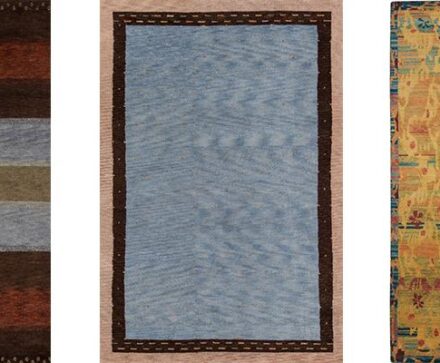How to Determine the Age of a Rug: Antique and Semi-antique Rugs
It’s not easy to determine the age of a rug. The best way to learn how is to get out there and experience as many rugs as possible to learn to spot the differences. Sam Presnell from The Rug Gallery talks about how to determine a rug’s age. Listen or read more to find out how experts age a rug.
John Maher: Welcome to The Rug Gallery, with Sam Presnell. The Rug Gallery is an Oriental rug company and carpet store in Cincinnati, Ohio. I’m John Maher, I’m here with the owner of The Rug Gallery, Sam Presnell. Hi, Sam.
Sam Presnell: Hi, John.
John: Today we’re talking about how to determine the age of a rug, antique and semi-antique rugs. Sam, what determines if a rug is an antique rug?
Sam: It’s all about age and that’s how we frame it, but a lot of people have different points of age which they consider antique and other people have other times they think it is. I’m a big believer in that it has to be a hundred years old. Some of my colleagues think 75 years is enough to be an antique, I think a hundred is where I think the majority of people come down as far as age for a rug to be truly what we call an antique rug. Then, semi-antique would fit in that criteria probably anywhere from about 50 to a hundred — that 75-year-old would be a semi-antique or pretty darn close, but not quite there.
How to Determine a Contemporary Rug’s Age
John: Okay. Then what would determine if a rug is a contemporary rug?
Sam: A contemporary rug is a confusing term when it comes to rugs because it just means it’s more of a modern rug it’s, I would say, anything from basically 10 years old to 50 years old would be considered a contemporary rug. 50 years old seems like a very old rug to a lot people I’m sure, but for a guy that collects Oriental rugs or rugs in general, that is pretty new for rug collecting.
John: Can contemporary mean more of the style of the rug to as opposed to just the age?
Sam: Not if you’re a collector. A contemporary rug would not determined [by] style in a modern fashion, it’s more about its age again. The classifications are more like times of age, of years.
Value of Antique and Semi-antique Rugs
John: Is there a certain value or cost of a rug that gets added on if a rug is an antique rug or a semi-antique rug?
Sam: Definitely, I always try to equate it to a lot of people are into cars and as cars get older, they get more valuable because there’s less and less of them. Once the rug passes that threshold of a hundred years old, that’s antique territory and if it was in good shape. Also, what determines a rug’s value is also how many are in the marketplace, so the more rare and more scarce of a certain type or style or colorway, then condition: is any repair done to it, is it worn? Is it stained? Those all can play into that value equation, but a hundred years makes a big difference. I would say from a semi-antique to the antique, it can most times I’d say at least be double to quadruple depending on [its] condition from what maybe a semi-antique between that 50 and a hundred years old maybe.
How to Spot Contemporary, Semi-antique, and Antique Rugs
John: If it makes that much difference, obviously somebody is looking for an old rug like that you’d want to know what the difference is, how can you tell the difference between contemporary rug, a semi-antique, and an antique rug?
Sam: Well, that’s hard to say because I have to say it comes from a lot of handling, buying, selling, touching and knowing something about a rug. A lot of times, a rug that’s not been abused and has been taken care of and stored properly is very hard to tell from a rug that’s a lot younger and not as old as that rug. Mostly, it has to do with, one, usually the foundation which it’s put upon, certain things are like cut-off points as far as Oriental rugs go — like when we switch from wool foundation to cotton foundation that determines a period of time about turn-of-the-century. But in tribal rugs, they also use wool foundations today so that’s not the end-all be-all.
There are certain things you’re going to look at: color, certain colors of certain areas that were around, but those are things you have to learn that is not something that you can teach. I could probably read about it, but then it’s hard to describe a color sometimes in words and sometimes you have to see and feel it. Also, color oxidizes or it changes, and as it changes it tends to fade and starts losing some of its top color. You start getting this depth of color, I call it, in an antique rug that is really warm and inviting whereas when in brand-new [rugs], it’s a lot brighter and it feels newer, you know what I mean?
But if a rug is taken care of, it’s never seen the light of day, and it’s been in an attic and rolled up and stored for a hundred years, that could still be bright. You’d be shocked at how sometimes a hundred-year rug could be in such great color and still be that old. And if it’s used in the open with sunlight and it’s gotten wear and tear, that coloration is going to be totally different than something that didn’t get that kind of wear and tear.
Semi-antique Rugs Could Look Older Than Antique Rugs
John: Right, so you could actually end up with maybe a semi-antique rug that’s in worse shape than an antique rug and it looks older and it’s not really?
Sam: Yes. One of the real popular things in America — there’s two rugs that are really popular in America — and especially in older rugs, one is the Sarouk, which was pretty much a direct import. We probably had the majority, whenever silks were made were imported … or exported … into the U.S., and the same with Kerman. The majority of the Kermans, especially with certain colorways and designs, were pretty much a U.S. import and the rest of Europe and the rest of the world didn’t really get those type of rugs. We have certain rugs that are easy to date because of we had so many come in and we see so many of them.
Then also in the old days between then — I would say the 20s, the 30s periods — there was what we call washed and painted, which doesn’t seem so crazy today [with] what we’re doing to rugs, but back in the time, if a rug came in and the color wasn’t where the American market wanted the color to be — you got to remember, these are the roaring 20s. These are color and Deco nouveau was happening. The color was changing. A lot of those colors were not really what the customer wanted. So, what they would do they had these wash houses and painting houses, in New York, and they would actually strip the color out, they basically bleach it out, caustic somehow, and then they would repaint with inks and a pen and re-dye the background of that rug to be whatever color red that they thought was the right red for that period of time.
When you look at it today, when you look at the back of a washed and painted rug, when you flip over to back, you will see that the back is lighter than the top which is darker. If you look around the design you start seeing fading of coloring around the design because they didn’t get that dye in there as tight. Usually on an old rug when you look at the back you’re going to see it’s a darker coloration than the top because the tops are where all the light and wear and tear is. When you see that automatically it just — that’s a 1920s, 30s washed and painted — you see it and you know it.
John: Right, because that was the only time period when they did that sort of technique yes.
Sam: It is little things like that, there’s little things they did with fringes, there’s little things they did with edging that are in certain areas that are very common. A lot has to do with colors and the colors available back then. Remember, transportation was not what it is today. A lot of these places they were pretty much nomads, and if you got around it was a truck every now and then or a train if you were lucky and most time, the colors that were indigenous to that area is what they put in the rug, whereas in later years you see a lot of colors that were not indigenous to that area and those rugs have different colorings today in modern or newer rugs than they did at that time of the century.
Same Techniques Used Then and Now
John: Do you think that one of the issues in determining the age of a rug is because that even today those rug manufacturers, those rug weavers, are still using the same tried-and-true techniques that they used you a hundred or 200 years ago?
Sam: Yes. That’s the thing that I think is really pleasing to me is to see a lot of those old techniques are still being done today the way they were done originally, hundreds of years ago. To me that’s a part I really enjoy the most. A lot times, it’s really hard to tell some of these reproductions at a distance that you realize that ‘wow that looks like a nice a hundred-year-old rug’ but you get on top of this like, ‘oh it’s new but what a great job’.
John: All right. Well, that’s great. Excellent to talk to you today, Sam. I appreciate it.
Sam: All right, John. You’re welcome.John: For more information about Sam, the Rug Gallery and Oriental rugs and carpets visit RugGalleryCincy.com, that’s ruggallery C-I-N-C-Y.com or call 513-793-9505. Make sure you catch the latest episodes by subscribing to this podcast on iTunes and if you can take the time to give us a review on iTunes as well would appreciate that. See you next time on the Rug Gallery.


